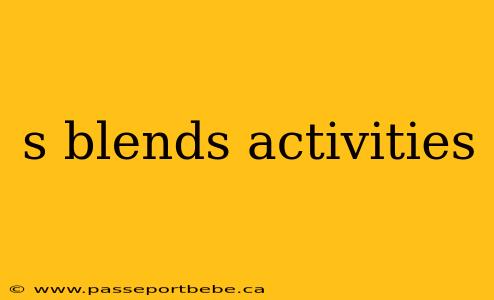S blends are essential phonetic combinations that help children develop their reading and speaking skills. These blends typically involve an "s" followed by another consonant, creating a smooth, continuous sound. Engaging in fun and educational activities can significantly enhance a child's understanding and mastery of s blends.
What are S Blends?
S blends consist of the letter "s" combined with other consonants, resulting in sounds like "sl," "sm," "sn," "sp," and "st." Examples include:
- sl: slide, slim, sloth
- sm: smell, smile, small
- sn: snow, snap, snack
- sp: spider, spark, speak
- st: star, stop, stamp
Understanding these blends is crucial for improving phonemic awareness, which is a foundational skill for reading.
Fun Activities for Teaching S Blends
1. S Blend Bingo
Materials Needed: Bingo cards with s blend words, markers.
How to Play: Create bingo cards featuring various s blend words. Call out the words, and students will cover the corresponding square on their cards. This activity helps reinforce word recognition and listening skills.
2. S Blend Word Hunt
Materials Needed: S blend word list, magazines or books.
How to Play: Ask students to find and cut out pictures or words from magazines that contain s blends. They can create a collage or a poster displaying their findings, which helps with visual recognition of s blends.
3. S Blend Sorting
Materials Needed: Word cards with different blends.
How to Play: Prepare cards with different s blend words and other blends. Have students sort the cards into categories based on whether they contain s blends or not. This activity reinforces phonics and categorization skills.
4. S Blend Memory Game
Materials Needed: Matching cards with s blend words and images.
How to Play: Create pairs of cards, one with an image and the other with the corresponding s blend word. Place them face down and take turns flipping over two cards to find matches. This game enhances memory and word recognition.
5. S Blend Story Creation
Materials Needed: Paper, markers or crayons.
How to Play: Encourage students to write and illustrate their own short stories using as many s blend words as they can. This creative exercise helps reinforce vocabulary in a fun and imaginative way.
Conclusion
Engaging in these s blends activities can make learning enjoyable and effective for children. By incorporating games and hands-on tasks, educators and parents can create a stimulating environment that fosters phonemic awareness and literacy skills. Remember, practice and repetition are key to mastering s blends!
